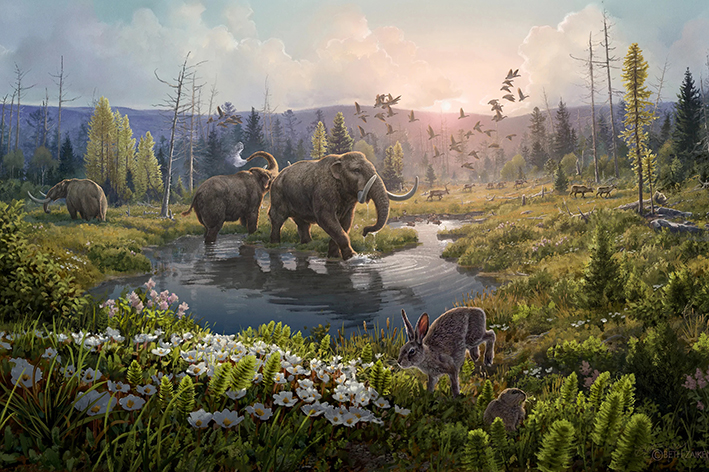
A DNA Adventure of Two Million Years
Greenland is the largest island in the world, stretching 2,670 km from south to north and 1,050 km from east to west. Two-thirds of Greenland falls within the Arctic Circle, and about 80 percent of the entire island is covered by an ice sheet with an average thickness of 1,500 metres. In winter, the average temperature is around -7℃ in the south and -34℃ in the North –not really favourable for life. This is exactly why Erik the Red, who was expelled from Iceland after being accused of murder in 982 and settled in Greenland, named this new land “Greenland” in order to attract more people to the island. Even if we would not expect honesty from Erik, we have just discovered a grain of truth in his choice of name. Through new DNA research, we have a learned that Greenland had a unique ecosystem about 2 million years ago, covered with poplar and birch trees, and populated with animals such as mastodon (a distant relative of the elephants), deer, geese, ants, and fleas, with crabs roaming the coral reefs along its shores.
The study, published in Nature, is the first to use genetic technology to reveal such an ancient landscape. The analysed samples are about 2.4 million years old. Another study conducted in 2021 analysed DNA from a 1.2-million-year-old Siberian mammoth. The record before that belonged to a 750-thousand-year-old horse.
Scientists who wish to paint pictures of ancient, lost worlds do so with fossils. This is because DNA degrades rapidly under environmental conditions and cannot provide useful genetic information. However, 41 DNA samples collected from the Kap København region in northern Greenland since 2006 have opened the doors to the past for scientists, as they were almost perfectly preserved under the permafrost. Normally, such old DNA samples are not common. Every living thing leaves a good amount of itself to its environment throughout its life; in the form of hair, dead skin particles, or faeces. The DNA obtained from these reveals what species they belong to, just like a barcode. Such DNA fragments belonging to plants, animals and microbes that once lived are called the environmental-DNA, or eDNA. These samples help scientists work like a crime scene investigation team, tracking all the species that lived in that environment.
While this technology is still new, biodiversity monitoring has previously been used for studying invasive species and discovering new species. On the other hand, using eDNA to revitalize an entire prehistoric ecosystem attaches a special meaning and importance to this study, making it a first.
Scientists began collecting these DNA samples in 2006. At first, they weren’t sure if they could find any useful eDNA. They relentlessly chased clues with new methods. “We were looking at the samples over and over, and we failed every time until two years ago,” says Eske Willerslev from the research team.
With the advances in technology, Willerslev’s colleague geobiologist Karina Sand developed new methods for detecting specific minerals likely to carry eDNA. The researchers then targeted samples made of quartz and clay particles, managed to extract eDNA, and finally succeeded in sequencing it. They began trials to match these sequences by comparing with other eDNA fragments at hand. Most of the eDNA samples did not match any modern species, or even fossil records. The researchers then started examining species that could be close relatives, and identified similarities with species that had never been recorded in the northern polar region before. They finally determined that mastodons, reindeer, rodents, geese, ant and flea-like insects, as well as sea creatures such as coral and horseshoe crabs, lived in area 2.4 million years ago. Some of these species can still be found in Greenland today, but Greenland is now too cold for most of them. This makes one think about the climate records from 2.4 million years ago, as temperatures in the region were 11-19°C higher at that time.
A similar situation is also valid for plants. The fact that the researchers identified broad-leaved trees such as poplar and birch, in addition to shrubs native to the arctic region indicates that mild and arctic climate conditions coexisted. This is a climate combination that we do not currently see, although it doesn’t mean we will not see it anytime soon. As current climate conditions are changing rapidly due to human-induced global warming, it is quite possible that similar conditions may be seen at the poles. In natural processes, plants and animals can keep up with this change and adapt by migrating. However, the climate change we are facing right now can progress so fast for species to adapt, and it may not be possible for plants to retreat to distances of over thousands of kilometres. In this case, herbivorous animals that feed on plants will not stand much of a chance either.
Researchers state that they found no traces of carnivorous animals in this study, also saying that it is unrealistic not to have any carnivores in such a complex ecosystem. Therefore, they will likely find DNA fragments of carnivorous animals in future trials.
According to Willerslev, “If we can begin to explore ancient DNA we may be able to gather ground-breaking information about the origin of many different species — perhaps even new knowledge about the first humans and their ancestors. The possibilities are endless.”
REFERENCES
- 1. https://www.britannica.com/place/Greenland
- 2. https://www.livescience.com/worlds-oldest-dna-greenland-ecosystem
- 3. https://www.nhm.ac.uk/discover/news/2022/december/worlds-oldest-dna-represents-two-million-year-old-ecosystem.html
- 4. https://www.popsci.com/environment/oldest-dna-analysis-greenland
- 5. https://www.science.org/content/article/mammoth-molars-yield-oldest-dna-ever-sequenced
